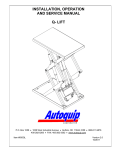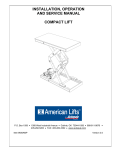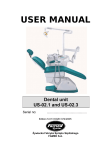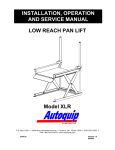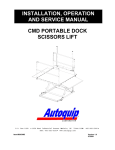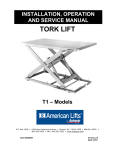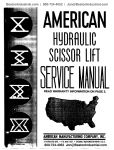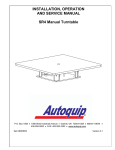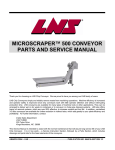Download INSTALLATION, OPERATION AND SERVICE MANUAL TORK LIFT
Transcript
INSTALLATION, OPERATION AND SERVICE MANUAL TORK LIFT T2/T3 – Models P.O. Box 1058 • 1058 West Industrial Avenue • Guthrie, OK 73044-1058 • 888-811-9876 • 405-282-5200 • FAX: 405-282-3302 • www.autoquip.com Item #830AMT2_T3 VERSION 1 August 16, 2011 1 1. 2. 3. 4. 5. 6. 7. 8. INTRODUCTION AND WARRANTY...............................................................................................................3 1.1 Introduction ............................................................................................................................................................... 3 1.1.1 Identification ............................................................................................................................................. 3 1.1.2 Inspection.................................................................................................................................................. 3 1.1.3 Planned Maintenance Program ................................................................................................................. 3 1.2 Responsibility Of Owners/Users ................................................................................................................................. 3 1.2.1 Deflection .................................................................................................................................................. 3 1.2.2 Inspection & Maintenance ........................................................................................................................ 4 1.2.3 Removal From Service ............................................................................................................................... 4 1.2.4 Repairs ...................................................................................................................................................... 4 1.2.5 Operators .................................................................................................................................................. 4 1.2.6 Before Operation....................................................................................................................................... 4 1.2.7 During Operation ....................................................................................................................................... 4 1.2.8 Modifications Or Alterations ..................................................................................................................... 4 1.3 Warranty .................................................................................................................................................................... 5 2.1 2.2 2.3 2.4 2.5 2.6 2.7 SPECIFICATIONS ................................................................................................................................................6 T2 Models ................................................................................................................................................................... 6 T3 Models ................................................................................................................................................................... 7 Lift Specifications........................................................................................................................................................ 8 Load Capacity ............................................................................................................................................................. 8 Unbalanced Loading ................................................................................................................................................... 8 Pump Pressure............................................................................................................................................................ 8 Lift Duty ...................................................................................................................................................................... 8 SAFETY ..................................................................................................................................................................9 3.1 3.2 3.3 3.4 3.5 3.6 3.7 4.1 4.2 4.3 4.4 Safety Signal Words .................................................................................................................................................... 9 Installation ................................................................................................................................................................. 9 Operation ................................................................................................................................................................. 10 Hydraulics ................................................................................................................................................................. 10 Maintenance ............................................................................................................................................................ 11 Modifications ........................................................................................................................................................... 11 Labels ....................................................................................................................................................................... 12 INSTALLATION ................................................................................................................................................ 15 Pit Installation .......................................................................................................................................................... 15 Shimming And Anchoring Lift To Concrete................................................................................................................ 17 Remote Power Unit Installation ............................................................................................................................... 17 Power Unit Wiring .................................................................................................................................................... 18 4.4.1 Intermittent Duty Remote Power Units ....................................................................................................18 4.4.2 Heavy Duty Remote Power Unit ...............................................................................................................18 OPERATION ...................................................................................................................................................... 19 5.1 Raise and Lower Lift ................................................................................................................................................. 19 MAINTENANCE ................................................................................................................................................ 20 6.1 Maintenance Devices ............................................................................................................................................... 20 6.2 Routine Maintenance ............................................................................................................................................... 22 6.2.1 Every Day Or 10 Hours Of Operation .....................................................................................................22 6.2.2 Every Month Or 100 Hours Of Operation ...............................................................................................23 6.2.3 Every Year Or 1000 Hours Of Operation................................................................................................23 6.2.4 Oil Requirements......................................................................................................................................23 6.2.5 Oil Capacity ..............................................................................................................................................23 6.3 General Maintenance ............................................................................................................................................... 24 6.3.1 Hydraulic Cylinder Repair .........................................................................................................................24 6.3.2 Bleeding Air From System .........................................................................................................................26 6.3.3 Hydraulic Velocity Fuse (HVF) Replacement .............................................................................................26 6.3.4 Hose Orientation ......................................................................................................................................27 TROUBLESHOOTING ..................................................................................................................................... 31 PARTS LISTS ..................................................................................................................................................... 35 2 1. INTRODUCTION AND WARRANTY 1.1 Introduction Please read and understand this manual prior to installation or operation of this lift. Failure to do so could lead to property damage and/or serious personal injury. If you have any questions, call a local dealer or Autoquip Corporation at 1-888-811-9876 or 405-282-5200. Please record the following information and refer to it when calling your dealer or Autoquip. Model Number:________________Serial Number: ___________________ Installation Date _____/_____/_____ 1.1.1 Identification When ordering parts or requesting information or service on this lift, PLEASE REFER TO THE MODEL AND SERIAL NUMBER. This information is on a nameplate attached to the leg assembly. Replacement parts are available from a local Autoquip distributor. 1.1.2 Inspection Upon receipt of lift, perform a visual inspection to determine that lift not been damaged in transit. Any damage found must be noted on delivery receipt. In addition to this preliminary inspection, carefully inspect lift for concealed damage. Any concealed damage found that was not noted on delivery receipt must be reported in writing to the delivering carrier within 48 hours. Use the following checklist for inspection of lift: 1. Examine entire unit for any signs of mishandling. Carefully check power unit and push buttons. 2. Thoroughly examine all connections, making sure they have not vibrated loose during transit, and inspect wiring for any signs of damage. 3. After installation, raise lift and inspect base frame, platform, scissors assembly, and cylinder plumbing connections. 1.1.3 Planned Maintenance Program A local Autoquip representative provides a Planned Maintenance Program (PMP) for this equipment using factory-trained personnel. Call a local representative or Autoquip Corporation at 1-888-811-9876 or 405-282-5200 for more information. 1.2 Responsibility Of Owners/Users 1.2.1 Deflection It is the responsibility of user/purchaser to advise manufacturer where deflection may be critical to the application. 3 1.2.2 Inspection & Maintenance Lift must be inspected and maintained in accordance with Autoquip’s operating/maintenance (O&M) manual and with other applicable safe operating practices. 1.2.3 Removal From Service Any lift not in safe operating condition such as, but not limited to, excessive leakage, missing parts or fasteners, any bent or cracked structural members, cut or frayed electric, hydraulic, or pneumatic lines, damaged or malfunctioning controls or safety devices, etc. shall be removed from service until it is repaired to the original manufacturer’s standards. 1.2.4 Repairs All repairs must be made by a qualified technician in conformance with Autoquip’s instructions. 1.2.5 Operators Only trained personnel and authorized personnel shall be permitted to operate lift. 1.2.6 Before Operation Before using lift, operator must: • Read and/or had explained, and understood, manufacturer’s operating instructions and safety rules. • Inspected lift for proper operation and condition. Any suspect item must be carefully examined and a determination made by a qualified person as to whether it constitutes a hazard. All items not in conformance with Autoquip’s specification must be corrected before operating lift. 1.2.7 During Operation Use lift in accordance with Autoquip’s O&M manual. • Do not overload lift. • Verify all safety devices are operational and in place. • Autoquip warrants this lift for 60,000 cycles each warranty year. This number of cycles represents normal, single shift duty. Exceeding this number of cycles shortens life of lift and length of your warranty. 1.2.8 Modifications Or Alterations Modifications or alterations to this equipment may be made only with written permission of Autoquip. Unauthorized modification or alteration will void warranty. 4 1.3 Warranty The user is solely responsible for using this equipment in a safe manner and observing all of the safety guidelines provided in the Owner’s Manual and on the warning labels provided with the lift. If you are unable to locate either the manual or the warning labels, please contact Autoquip or access www.autoquip.com for replacement downloads or information. Autoquip Corporation expressly warrants that this product will be free from defects in material and workmanship under normal, intended use for a period of Two (2) Years for Labor and all electrical, mechanical, and hydraulic components, parts or devices, and warrants the structure of the lift against breakage or failure for a period of Five (5) years. The warranty period begins from the date of shipment. When making a claim, immediately send your dealer or Autoquip notice of your claim. All claims must be received by Autoquip within the warranty time period. The maximum liability of Autoquip, under this Limited Warranty, is limited to the replacement of the equipment. This warranty shall not apply to any Autoquip lift or parts of Autoquip lift that have been damaged or broken in transit/shipping, or due directly or indirectly to misuse, abuse, vehicle impact, negligence, faulty installation, fire, floods, acts of God, accidents, or that have been used in a manner contrary to the manufacturer’s limitations or recommendations as stated in the manual, or that have been repaired, altered or modified in any manner outside of Autoquip Corp’s manufacturing facility or which have not been expressly authorized by Autoquip. Autoquip Corporation makes no warranty or representation with respect to the compliance of any equipment with state or local safety or product standard codes, and any failure to comply with such codes shall not be considered a defect of material or workmanship under this warranty. Autoquip Corporation shall not be liable for any direct or consequential damages resulting from such noncompliance. Autoquip Corporation’s obligation under this warranty is limited to the replacement or repair of defective components at its factory or another location at Autoquip Corp’s discretion at no cost to the owner. This is owner’s sole remedy. Replacement parts (with exception of electrical components) will be warranted for a period of ninety (90) days. Except as stated herein, Autoquip Corporation will not be liable for any loss, injury, or damage to persons or property, nor for direct, indirect, or consequential damage of any kind, resulting from failure or defective operation of said equipment. All parts used to replace defective material must be genuine Autoquip parts in order to be covered by this Limited Warranty. AUTOQUIP CORP P.O. Box 1058, Guthrie, OK 73044-1058 Telephone: (888) 811-9876 ∙ (405) 282-5200 Fax: (405) 282-3302 www.autoquip.com 5 2. SPECIFICATIONS 2.1 T2 Models Model Cap. (Lbs.) Travel (In.) Lowered Height (In.) Raised Height (In.) Max End Load (Lbs.) Max Side Load (Lbs.) Std Min. Platform (In.) Raise Time (sec) No of Cyl Ship Wt. (Lbs.) T2-36-020 2000 36 10.5 46.5 1000 660 26 x 32 13 1 1800 T2-60-020 2000 60 11.5 71.5 1000 660 23 x 47.25 21 1 2000 T2-60-040 4000 60 11.75 71.75 2000 1320 33 x 47.25 42 2 2100 T2-72-020 2000 72 14 86 1000 660 47 x 56 26 1 1500 T2-72-040 4000 72 13.75 85.75 2000 1320 47 x 56 35 1 1600 T2-72-060 6000 72 16.75 88.75 3000 1980 35 x 56 35 1 2200 T2-72-080 8000 72 16.75 88.75 4000 2640 37 x 56 70 2 2800 T2-72-100 10000 72 18.125 90.125 5000 3300 45 x 57 71 2 3200 T2-84-100 10000 84 18.125 102.125 5000 3300 45 x 71 86 2 3500 T2-96-020 2000 96 15.125 111.125 1000 660 47 x 66 50 2 1600 T2-96-040 4000 96 16.75 112.75 2000 1320 42 x 76 40 2 1900 T2-96-060 6000 96 19.5 115.5 3000 1980 48 x 82 45 2 2200 T2-96-080 8000 96 19.5 115.5 4000 2640 48 x 80 45 2 2400 T2-120-020 2000 120 14.8125 134.8125 1000 660 46 x 94 40 2 1700 T2-120-040 4000 120 16.75 136.75 2000 1320 60 x 95 45 2 1900 T2-120-060 6000 120 20 140 3000 1980 48 x 96 55 2 2300 T2-144-020 2000 144 21 165 1000 660 72 x 96 45 2 1800 T2-144-040 4000 144 21 165 2000 1320 60 x 117 50 2 2100 T2-144-060 6000 144 21 165 3000 1980 60 x 117 65 2 2200 6 2.2 T3 Models Model Cap. (Lbs.) Travel (In.) Lowered Height (In.) Raised Height (In.) Max End Load (Lbs.) Max Side Load (Lbs.) Std Min. Platform (In.) Raise Time (sec) No of Cyl Ship Wt. (Lbs.) T3-48-040 4000 48 16.5 64.5 1600 1000 32 x 33 35 3 2725 T3-48-060 6000 48 19 67 2400 1500 34 x 34 35 3 2775 T3-60-020 2000 60 15.75 75.75 800 500 50 2 2695 T3-60-040 4000 60 17.0625 77.0625 1600 1000 24 x 38.88 32 x 39 40 3 2875 T3-60-060 6000 60 17.0625 77.0625 2400 1500 32 x 39 45 3 2950 T3-72-020 2000 72 15.75 87.75 800 500 30 x 44 60 2 2775 T3-72-040 4000 72 17.5625 89.5625 1600 1000 34 x 45 45 3 3050 T3-72-060 6000 72 18.4375 90.4375 2400 1500 32 x 45 50 3 3195 T3-84-020 2000 84 17.0625 101.0625 800 500 32 x 51 40 2 2950 T3-84-040 4000 84 19.5625 103.5625 1600 1000 40 x 58 55 3 3075 T3-84-060 6000 84 22 106 2400 1500 36 x 54 55 3 3395 T3-96-020 2000 96 17.0625 113.0625 800 500 38 x 56 40 2 3150 T3-96-040 4000 96 20.5625 116.5625 1600 1000 40 x 58 30 3 3595 T3-96-060 6000 96 21.25 117.25 2400 1500 46 x 59 45 4 3675 T3-108-020 2000 108 18.625 126.625 800 500 42 x 63 45 2 3150 T3-108-040 4000 108 22 130 1600 1000 48 x 64 35 3 3595 T3-108-060 6000 108 23.5 131.5 2400 1500 54 x 65 45 4 3675 T3-120-020 2000 120 18.5625 138.5625 800 500 48 x 69 50 2 3475 T3-120-040 4000 120 22.5625 142.5625 1600 1000 48 x 70 40 3 3875 T3-120-060 6000 120 22.5625 142.5625 2400 1500 56 x 70 55 4 3975 T3-132-020 2000 132 22 154 800 500 54 x 75 55 2 3825 T3-132-040 4000 132 25.0625 157.0625 1600 1000 56 x 77 60 2 3050 T3-132-060 6000 132 25.0625 157.0625 2400 1500 56 x 77 40 2 3175 T3-144-020 2000 144 22.5625 166.5625 800 500 56 x 81 35 2 3950 T3-144-040 4000 144 22.5625 166.5625 1600 1000 56 x 81 35 3 4200 T3-144-060 6000 144 25.75 169.75 2400 1500 48 x 82 45 2 4450 7 2.3 Lift Specifications Only standard models are shown in the specification table, there are many custom designs whose specifications may vary from these. Please consult the specific General Arrangement (GA) Drawing to obtain the specifications for application-specific designs. 2.4 Load Capacity Load capacity rating is stamped on a metal plate attached to lift. This figure is a net capacity rating for a lift furnished with a standard platform. If optional items are installed on lift after leaving manufacturer, deduct weight of these from load rating to obtain net capacity. Do not exceed rated capacity of lift. Loading lift beyond its rated capacity is unsafe, will shorten operational life of lift, and will void warranty. 2.5 Unbalanced Loading The stabilization provided is basically for balanced loads. If special attachments extend beyond the length and/or width dimensions of platform, end and/or side load capacity is reduced 2% for each one-inch extension from center. If load is rolling onto platform (in any but fully-lowered position) end and/or side load capacity is reduced by a 50% impact factor (i.e., divide rated end/side load by 1.50 to establish an available “axle” load). 2.6 Pump Pressure This lift incorporates a unique, positive displacement pump. Therefore, standard factory models of same manufacture cannot replace it. Pump can operate efficiently at intermittent pressures up to 2000 PSI and continuous duty to 1500 PSI. Factory installed safety relief valve in pump is factory-set to stay within parameters of pump and lift requirements. 2.7 Lift Duty Autoquip standard lifts typically include intermittent duty motors and are designed to “cycle” (one complete “up” and one complete “down” lift operation) no more frequently than every two minutes – or approximately 60,000 times (cycles) per year. This is considered “normal” duty. It is the responsibility of the user to notify Autoquip whenever a specific application is likely to demand “above normal” duty from lift. Above normal duty typically requires supplemental design features to enhance serviceable life of lift and to avoid loss of warranty. 8 3. SAFETY 3.1 Safety Signal Words This Owner’s Manual covers T2-T3 Torklift produced by Autoquip. Before installing, operating or servicing lift, you must read, understand and follow the instructions and safety warnings in this manual. Your lift may not be equipped with some optional equipment shown in this manual. The safety information in this manual is denoted by the safety alert symbol: The level of risk is indicated by the following signal words. DANGER – Indicates a hazardous situation, which, if not avoided, will result in death or serious injury. WARNING – Indicates a hazardous situation, which, if not avoided, could result in death or serious injury. CAUTION – Indicates a hazardous situation, which, if not avoided, could result in minor or moderate injury. NOTICE – Indicates a situation that could result in damage to the lift or other property. 3.2 Installation Do not install lift in a pit unless pit has a bevel toe guard or other approved toe protection. A shear point can exist which can cause severe foot injury. Lift platforms traveling below floor levels may create a toe hazard as load passes top edge of pit. This may require guarding in accordance with Federal Regulations. Guarding must be installed prior to operating lift. Prevent serious injury or death. Depending on model, weight of lift ranges from 1500 – 4450 lbs. Use a properly rated lifting device to move and install lift. 9 3.3 Operation Prevent serious injury or death. Scissor lifts are designed for a specific load and application. Do not change load or application from original design. Overloading, or uneven loading, could result in load instability and cause serious personal injury. Stay clear of lift while lift is in motion. Never stand, sit or ride on lift. Prevent serious injury or death. Lifts which travel to an elevation above floor level where distance between floor and the underside of lift platform exceeds 60" must have the scissors mechanism guarded per ANSI MH29.1. 3.4 Hydraulics Fluids can be hazardous. Before servicing lift, check Material Safety Data Sheet (MSDS) to understand the product, safe handling procedures, and first aid measures relating to product. Follow this information when servicing or repairing lift. Do not drain or pour any fluids or lubricants into ground. Check with local environmental agencies, recycling centers, or your Autoquip dealer for correct disposal information. Any time velocity fuses have been tripped, investigate cause of trip and verify necessary corrective actions have been taken prior to operation of lift. Prevent serious injury or death. Do not attempt to remove Hydraulic Velocity Fuse (HVF) until maintenance device securely supports lift and all hydraulic pressure has been relieved. 10 HVF is attached to elbow fitting in rod port of cylinder. Do not use a swivel fitting between HVF and cylinder. If HVF is installed improperly, it will not lock up in event of a hydraulic line failure. Pressurized fluids can penetrate the skin. Hydraulic hoses can fail from age, damage and exposure. Do not search for hydraulic leaks without body and face protection. A tiny, almost invisible leak can penetrate the skin, thereby requiring immediate medical attention. Use wood or cardboard to detect hydraulic leaks, never your hands. Spilled fluids and lubricants may be slippery and may also present a fire hazard. Clean up spilled fluids and lubricants. 3.5 Maintenance Prevent serious injury or death. Disconnect and/or lock out electrical supply to power unit prior to any maintenance being performed. Prevent serious injury or death. Never go under lift platform until load is removed and scissors mechanism is securely blocked in raised position with maintenance devices. 3.6 Modifications Prevent serious injury or death. Do not modify lift. Autoquip cannot foresee and is not responsible for injury or damage which results from unauthorized modifications or misuse of lift. 11 3.7 Labels 12 A – 36400661 B – 36401487 C – 36401560 D – 36430050 If Not Equipped With Handrails D – 36430050M If Equipped With Handrails, Cut As Shown 13 E – 36401586 F – 36403230 N/S – 36403715 If Equipped With Handrails N/S – 36403343 To protect against death or serious injury, all labels must be on lift and must be legible. If any of these labels are missing or cannot be read, call Autoquip for replacement labels. 14 4. INSTALLATION 4.1 Pit Installation Do not install lift in a pit unless pit has a bevel toe guard or other approved toe protection. A shear point may exist which can cause severe foot injury. Lift platforms traveling below floor levels may create a toe hazard as load passes top edge of pit. This may require guarding in accordance with Federal Regulations. Guarding must be installed prior to operating lift. Check pit dimensions. Pit must be 2" longer and 2” wider than lift platform to allow a 1” gap between platform and pit. Pit depth should allow ½” for shims or grout. Conduit (F) diameter must be a minimum of 2". A – Lift Platform B – 1” Gap Between Deck And Pit Wall C – Pit Access Hatch, Optional, Installed By Customer D – Pit Curb Angle, Suggested Min. L2” x 2” x ¼”, Cust. Inst. 15 E – Lift Anchor Points (4) F – 2” Min. Conduit, Cust. Inst. G – Suitable Pit Drain, Cust Inst. H – ½” Grout Under Base Verify installation area is clean before starting. Check mounting surface of pit floor with a level or straight edge. If floor is not level, add shims or grout under entire perimeter of base to achieve a level and flat base installation. A level base is essential for proper wheel tracking and smooth lift operation. Prevent serious injury or death. Depending on model, weight of lift ranges from 1500 – 4450 lbs. Use a properly rated lifting device to move and install lift. Lower lift into pit and check for proper height. Lift must be solid and flush with pit angle framing (D). If needed, shim to desired height. DO NOT “spot” shim. Shim along full length of frame. This will prevent frame from sagging under load. Prevent serious injury or death. Electrical service installation must be licensed electrician and conform to all electrical codes. performed by a local and national NOTE: For larger horsepower motors, consult factory. Temporarily connect electrical service and hydraulic hoses. Fill hydraulic reservoir with proper type and volume of fluid. Press “UP button and raise lift one foot. Press “DOWN” button to fully lower lift. Continue to hold down button for 60 seconds. Repeat procedure five to seven times to bleed air out of hydraulic system. Raise and lower lift as needed to make positioning adjustments. Adjust platform to a clearance of 1” minimum around perimeter between platform and pit angle. NEVER go under a raised lift platform until load is removed and lift is securely blocked in raised position with maintenance devices. See "Maintenance Device" section of this manual. 16 Lock-out/tag-out power source. Base frame of lift has pre-drilled holes for anchoring floor. Anchor lift to floor. Lifts with oversize platforms have minimum pull out requirements of 2,000 lbs. for each anchor. See “Shimming And Anchoring Lift To Concrete”. Make permanent electrical and hydraulic connections and operate lift through a few cycles. Clean up debris and spilled oil from area. Dispose of oil in an environmentally safe manner. Touch-up paint is available from Autoquip for repair of damaged paint surfaces. Train personnel on lift operation, all safety features and procedures. 4.2 Shimming And Anchoring Lift To Concrete Recommended concrete anchor bolts are: HILTI “Kwik-Bolt”, Molly Parabolt or similar. Verify lift is positioned correctly. Drill holes in concrete as specified by anchor bolt manufacturer. Install and tighten anchors as specified by anchor bolt manufacturer. After lift has been aligned, leveled and shimmed, and anchors have been installed, pour grout under entire base frame. When grout has set and cured, tighten nuts on anchor bolts. Route hydraulic hose or electrical cord through conduit in pit wall. 4.3 Remote Power Unit Installation The remote power unit is to be located in an area protected from the elements and should be installed prior to the lift to facilitate lift operation during installation into the pit. The remote contractor power unit is equipped with power unit mounting brackets and can be wall or floor mounted using these brackets. If equipped with a vertical power unit, optional power unit mounting brackets must be used for wall mounting. The electrical work is to be done in accordance with local codes by a qualified electrician. See the “Maintenance” section for the standard wiring diagram. If permanent electrical work is not complete, some means of temporary power with an on/off device for the motor will be required. Fill the reservoir with oil per instructions in the "Maintenance” section. 17 4.4 Power Unit Wiring HP and Voltage 1-½ HP: 60 CY / 3 PH Intermittent Duty Motor 5 HP: 60 CY / 3 PH Intermittent Duty Motor 5 HP: 60 CY / 3 PH Heavy Duty Motor Full Load Amperages 208 V= 4.8 Amps 230 V=4.6 Amps 460 V= 2.3 Amps 208 V=15.8 Amps 230 V=14.8 Amps 460 Volts = 7.4 Amps 208 V=16 Amps 230 V=15.2 Amps 460 V=7.6 Amps 208/230VAC 4 5 6 3 PHASE OPTIONAL THERMOSTATS J J MOTOR 1 7 2 8 3 460VAC 4 7 5 8 MOTOR 1 4.4.1 9 J J OPTIONAL THERMOSTATS 9 CONNECT TO LINE 5 HP motors 6 2 3 CONNECT TO LINE 1-½ HP motor Intermittent Duty Remote Power Units 1. The Intermittent Duty Power Units utilize a 1-½ or 5 HP / 208-230-460 Volt / 60 hertz / 3 phase “SuperTorque” intermittent duty motor with (one full lift cycle per 2 minute period) driving a high pressure positive displacement pump assembly with an internal relief valve, check valve and down solenoid valve. 2. Because an Autoquip "Super-Torque" motor actually delivers substantially more horsepower than the nameplate rating, it must always be wired for heavier current-draw than standard motors of the same nameplate rating. However, because of the "Super-Torque" motor’s starting efficiency and superior running characteristics, circuit components do not have to be as large as for standard motors of equal delivered horsepower. 4.4.2 Heavy Duty Remote Power Unit 1. The Vertical 'HD' Power unit utilizes a 5 HP/ 208-230-460 Volt / 60 hertz / 3 phase Heavy Duty motor, (with a 30 minute continuous duty rating). The power unit is coupled with a high-pressure positive displacement gear pump, and Autoquip Corporation’s patented Deltatrol valve assembly. 2. The motor connection diagram should be referenced in connecting the motors to a power source. Remember that heavy wire must be used all the way to the power source. 18 5. OPERATION 5.1 Raise and Lower Lift Prevent serious injury or death. Before operating lift, all personnel interacting with lift must read, understand and follow instructions and safety warnings in this manual. Adjusting safety relief valve may result in premature motor failure. Do not adjust safety relief valve. Raising loads exceeding rated capacity of lift may result in excessive wear and damage to lift. Prevent serious injury or death. Personnel must maintain a safe operating distance of at least 36” any time lift is operated. 1. Verify all personnel are away from lift. 2. Press “UP” button to raise lift. Release button when lift reaches desired position. Do not operate lift on relief for more than a few seconds. When on relief, valve will make a squealing sound. 3. Press "DOWN" button to lower lift. Release button when lift reaches desired position. 19 6. MAINTENANCE 6.1 Maintenance Devices NEVER go under a raised lift platform until load is removed and lift is securely blocked in raised position with maintenance devices. Lock-out/tag-out power source. This procedure describes the only factory-approved method of working under a lift. Follow these instructions EVERY time you plan to reach or crawl beneath the lift to perform service or maintenance – no matter how momentary that might be. If the factory-provided maintenance devices are damaged or missing, stop immediately and consult the factory for assistance. The manufacturer is not liable for your failure to use the approved maintenance devices and procedures that have been provided. 1. All loads must be removed from the lift prior to engaging the maintenance devices. These devices are designed to support an unloaded lift only. Failure to remove the load from the lift prior to blocking could cause the failure of the maintenance devices and allow the lift to fall unexpectedly. This can result in personal injury or death. 2. Raise the lift to its fully raised position. If you do not, the maintenance devices may not be able to be placed properly in their designed blocking position. 3. The lift will be provided with maintenance legs stored on one of the scissors arms, or with two (2) dropin maintenance locks stored on the outside of the base frame. The legs must be placed over pegs in top frame and within sockets in bottom frame (See Figure 6.1). Figure 6.1 20 Figure 6.2 The blocks must be securely placed inside the base frame and thus in the roller path of the lift (See Figure 6.2). 4. Lower the lift platform, either the platform rests securely on the maintenance legs (inside the sockets and over pegs), or until the leg rollers make contact with both maintenance blocks. Re-check to ensure that both devices are fully and properly engaged with the leg rollers. If both left and right maintenance locks are not fully engaged the lift could fall unexpectedly. If for any reason you are unable to lower the lift completely onto the maintenance devices, stop immediately and consult the factory. Failure to properly use the factory approved maintenance devices could result in severe injury or death. 5. Once the maintenance devices are properly and securely engaged, continue to press the down button, valve or switch for an additional 5-10 seconds to relieve all pressure in the hydraulic system (it could take longer in a pneumatic system). Failure to relieve operating system pressure could result in the sudden and unexpected release of high-pressure fluids (or air) during maintenance and/or repair of the lift, resulting in severe injury or death. 6. Follow OSHA electrical lock-out/tag-out procedures. Disconnect and tag all electrical and/or other power sources to prevent an unplanned or unexpected actuation of the lift. 7. Once inspection or work is complete, reverse the performance of the steps above to raise the lift off the maintenance devices and place the devices back into their designated storage positions. HIGH VOLTAGE!! – Disconnect and/or lock out the electrical supply to the power unit per OSHA regulations prior to any installation or maintenance being performed. 21 6.2 Routine Maintenance Prevent serious injury or death. Lock-out/tag-out power source prior to any maintenance being performed. Prevent serious injury or death. Never go under lift platform until load is removed and scissors mechanism is securely blocked in raised position with maintenance devices. See Maintenance Devices section. Pressurized fluids can penetrate the skin. Hydraulic hoses can fail from age, damage and exposure. Do not search for hydraulic leaks without body and face protection. A tiny, almost invisible leak can penetrate the skin, requiring immediate medical attention. Use wood or cardboard to detect hydraulic leaks, never your hands. Spilled hydraulic fluid is slippery and may also present a fire hazard. Clean up spilled hydraulic fluid. Normally, scissor lifts will require very little maintenance. However, a routine maintenance program could prevent costly replacement of parts and/or downtime. 6.2.1 Every Day Or 10 Hours Of Operation • • • • • • Check reservoir fluid level. Check for fluid leaks. Check all hoses and electrical cords for cracks, abrasions, twisting, etc. Small leaks at connections can be remedied by tightening connections or replacing faulty component. Check that oil pressure does not exceed 2,000 psi. Check all pivot joints & roller bearings for noise and wear. Check overall condition of unit (i.e. bends, breaks, loose or missing screws, etc.). 22 6.2.2 Every Month Or 100 Hours Of Operation • • • • • • Check quality of oil. Replace if discolored (oxidized), cloudy, or otherwise contaminated. Do not overfill reservoir. Always use clean fluid. Inspect lift cylinder rods for scoring and leaking, wipe away any foreign material. Inspect all structural and mechanical components for cracked, or broken welds and any distortion caused by collision, overloading, or other misuse. Inspect snap rings/bolts at rollers & pivot points for proper retention & tightness. Inspect cylinder base pin keeper bolts. Tighten if needed. Inspect all cylinder rod roll pins for proper seating & retention. When all checks have been completed, start unit and operate through all functions. Inspect all components for signs of noise, vibration, erratic movement, and any other abnormal behavior. 6.2.3 Every Year Or 1000 Hours Of Operation • • • • • 6.2.4 Change oil and clean reservoir. Always use clean fluid. Never return fluid from drip pans, pit, etc. back to reservoir. Dispose of and handle used fluid as a hazardous material. If noise or vibration has been noticed, remove lift cylinder pins, pivot pins, and roller bearings. Inspect for wear and replace as necessary. Inspect all hydraulic hoses, replace any that show signs of wear or leaking. Replace all filters. Check for permanent mechanical deformation. Oil Requirements Follow recommendations below that apply to your application. Environment (Ambient Temperature) Recommended Oil Indoor locations with variable temperatures: 5W 30 or 5W 40 Multiviscosity Motor Oil 30 - 100 degrees F. Indoor locations with constant temperatures: Permissible to use SAE 20 Motor Oil 60 - 80 degrees F. Outdoor locations: 30 - 120 degrees F. 5W 30 or 5W 40 Multiviscosity Motor Oil Outdoor locations: 10 degrees F below 0 to 100 degrees F. 5W 20 or 5W 30 Multiviscosity Motor Oil Cold Storage Warehouse: 10 - 40 degrees F. Contact local Autoquip Service Rep. Note: All oils are detergent type. 6.2.5 Oil Capacity Oil capacity varies between models. Capacity is between 2 quarts & 10 gallons. Use approved fluids only. Use of unauthorized fluids may cause damage to seals and hosing. Do Not Use: • Automatic Transmission Fluid (ATF) • Hydraulic Jack Oil • Hydraulic Fluids • Brake Fluids 23 6.3 General Maintenance 6.3.1 Hydraulic Cylinder Repair 6.3.1.1. Cylinder Removal 1. Raise lift to its full height and engage maintenance devices. See “Maintenance Devices”. 2. Disconnect electrical power to lift. Follow lock outtag out procedure. 3. Disconnect hose on cylinder base end and insert into oil-fill hole of reservoir. 4. Remove pin (A) on cylinder rod. 5. Remove bolts and retaining clips from cylinder base (B). 6. Remove cylinder from lift assembly. 7. Push piston rod into cylinder to eject as much oil as possible into a container. 6.3.1.2. Disassemble Cylinder 1. Using a spanner wrench, turn upper bearing assembly (A) clockwise until tip of retainer (B) appears in slot. Place a small screwdriver under retainer and turn it until retainer is completely removed. 2. Be sure hose port is open to allow air into cylinder. Pull piston rod out to remove rod, piston and bearing. 3. After all internal components have been removed, use a bright light to inspect inner walls (C) of barrel. Use a cylinder hone to remove any apparent nicks or scratches. Clean and flush barrel after honing. 24 4. Remove piston head nut (D) from rod. Upper clevis and pin may be used to prevent rotation of rod while loosening. Remove piston. 5. Inspect piston grooves for nicks or scratches that could affect seal or barrel walls. Replace piston if necessary. 6.3.1.3. Assemble Cylinder 1. Install and tighten piston head to rod. 2. Install new seals on piston. Liberally lubricate piston and seals with clean oil. 3. Insert piston into barrel. Do not to pinch or nick seals. 4. Slide bearing assembly (A) into place and align retainer hole with slot in barrel. 5. Turn bearing with spanner wrench until retainer (B) is inserted completely. 6.3.1.4. Install Cylinder 1. Install end of cylinder rod into crosshead mount. Align holes and insert pin (A). 2. Position cylinder base and install retainer clips (B) and bolts. Loctite PST #567 pipe thread sealant or equivalent is recommended. Do not use Teflon tape. Tape fragments may cause hydraulic system to malfunction. Prevent serious injury or death. HVF is attached to elbow fitting in rod port of cylinder. Do not use a swivel fitting between HVF and cylinder. If HVF is installed improperly, it will not lock up in event of a hydraulic line failure. Arrow on hydraulic velocity fuse indicates direction of oil flow restriction. Hydraulic velocity fuse must be installed with arrow pointing away from cylinder. 25 3. Connect cylinder hose(s). 4. Check that lift anchors are tight (when used). Check all pins and other mechanical and hydraulic connections. 5. Restore oil level. See oil recommendations in “Oil Requirements” section. 6. Turn on electrical power and press “UP” button. It may take a few seconds to fill empty cylinders. Raise lift approximately one inch and disengage maintenance devices. 7. Lower lift completely and hold “DOWN” button for 60 seconds to allow air in cylinders to bleed back into reservoir. 8. Raise lift to 25 – 50% of full travel, then lower and hold “DOWN” button for an additional 60 seconds. Repeat procedure 8 – 10 times. 9. Clean oil fill breather cap. 6.3.2 Bleeding Air From System 1. Bleed air from system by raising lift to 50% of full travel, then lower completely. 2. Hold “DOWN” button for 60 seconds. 3. Repeat procedure 5-6 times. If this does not bleed all air from system, contact Autoquip. 4. Clean up any spilled oil. Dispose of spilled oil in an environmentally safe manner. 6.3.3 Hydraulic Velocity Fuse (HVF) Replacement Prevent serious injury or death. Never go under lift platform until load is removed and scissors mechanism is securely blocked in raised position with maintenance devices and hydraulic pressure is relieved. The HVF is attached to elbow fitting in rod port of cylinder. Do not use a swivel fitting between HVF and cylinder. If HVF is installed improperly, it will not lock up in the event of a hydraulic line failure. Velocity fuse is not repairable. Replace velocity fuse if defective. 26 1. Arrow on hydraulic velocity fuse indicates direction of oil flow restriction. Hydraulic velocity fuse must be installed with arrow pointing away from cylinder. Do not use Teflon tape on hydraulic threaded connections. Tape fragments may damage hydraulic system. 2. Apply Loctite PST #567 pipe thread sealant or equivalent to threads and install fuse to cylinder with arrow pointing away from cylinder. Tighten fuse. 3. Fill reservoir to full mark if necessary with proper oil. 4. Check all fitting connections for hydraulic leaks and tighten as necessary. 5. Bleed air from system. See “Bleeding Air From System” in this section. 6.3.4 Hose Orientation To prevent damage to cylinder hoses, it is necessary to establish a correct hose shape and pattern of movement as follows: 1. Raise lift to its full height and block securely. See “Maintenance Devices”. 2. Install one end of new hose to cylinder fitting. 3. Since hose is fixed at both ends, it is possible to put a twist in hose that will allow it to describe the same pattern each time lift is operated. This twist will allow hose to travel about half way between cylinder on right side and inner leg on right side. 4. Lower lift carefully and verify hose is free and clear of cylinder and inner leg assembly. If not, twist hose in direction necessary to clear any obstruction and tighten swivel fitting. 27 Generic Hydraulic Schematic – Intermittent Duty (1-½ & 5HP) Power Units 28 Generic Hydraulic Schematic – Heavy Duty, 5HP Power Unit 29 Generic Electrical Schematic – 3PH Power Units 30 7. TROUBLESHOOTING Prevent serious injury or death. Disconnect and/or lock out electrical supply to power unit prior to any maintenance being performed. Prevent serious injury or death. Never go under lift platform until load is removed and scissors mechanism is securely blocked in open position. Follow OSHA lock-out/tag-out procedure. See "Maintenance Devices" section. Pressurized fluids can penetrate the skin. Hydraulic hoses can fail from age, damage and exposure. Do not search for hydraulic leaks without body and face protection. A tiny, almost invisible leak can penetrate the skin, thereby requiring immediate medical attention. Use wood or cardboard to detect hydraulic leaks, never your hands. Spilled hydraulic fluid is slippery and may also present a fire hazard. Clean up spilled hydraulic fluid. 31 PROBLEM Lift Raises, Then Lowers Slowly. POSSIBLE CAUSE AND SOLUTION Down solenoid may not be seating. Remove solenoid coil and check. If lift does not hold with solenoid coil removed, remove and clean down valve cartridge or replaced as necessary. Oil line, hose, or fitting may be leaking. Check and repair if necessary. Lift Lowers Slowly. Check valve in pump assembly may not be seating. This is indicated by pump shaft and motor turning backward on their own with no power applied. Generally, this condition can be heard. Replace pump assembly. Down solenoid is not operating properly due to debris or damage. Check for pinched tubing or hose. Where pipe is used, check for obstruction in line. Thick oil due to low ambient temperatures. Add or replace with lower weight oil that stays thin in cold conditions (5W-15, etc.) Lift Does Not Raise. If foam is visible in tank oil, check for loose connection in suction line between pump and tank. Tighten connections. Motor rotation for a 3-phase motor may be reversed. Reverse two motor electrical leads. Check for line or hose leak. Check for low oil in reservoir. Add specified oil as necessary. Load may exceed rating. See the Specifications section. Remove excess load. Suction screen may be clogged, starving pump. Remove and clean screen. Drain and replace oil. Suction line may be leaking air due to a loose fitting. Tighten as needed. 32 PROBLEM Lift Does Not Raise, Continued. POSSIBLE CAUSE AND SOLUTION Breather holes in reservoir fill plug may be clogged. Remove and clean. Voltage may be too low to run pump with existing load. Check by measuring voltage at motor terminals, or as near as possible, while pump is running under load. Inadequate or incorrect wiring can starve motor when source voltage is ample. Correct as necessary. Down valve may be energized by faulty wiring or stuck open. Remove solenoid and check. Motor may be single phasing. Check wiring, fuses, etc. Pump may be seized if motor is humming or blowing fuses on overload protection devices. Remove pump. Pump can be rotated by hand unless seized. Check for cracks in housing. Down solenoid valve stem may be bent, causing valve to stick open. Replace down solenoid valve. PROBLEM Lift Won’t Lower. POSSIBLE CAUSE AND SOLUTION Solenoid coil may be incorrectly wired, burned out, not rated for the voltage, or line voltage may be excessively low. Check voltage near coil. Velocity fuse may be locked. Do not attempt to remove the velocity fuse. The following steps should be followed: 1. Remove load from lift. Inspect all fittings, hoses, and other hydraulic components for leads or damage. 2. If no leak or damage is noticed, attempt to pressurize lifting cylinder by pressing “UP” button on controller for a few seconds. Immediately release “UP” button and press “DOWN” button. If lift starts to lower, continue pressing “DOWN” button until lift is fully lowered. 3. If lift does not lower after trying Step 2, wait approximately 10 – 15 minutes for pressure in hydraulic system to equalize. Then, press “DOWN” button until lift is fully lowered. 4. Once lift is fully lowered, hold “DOWN” button for approximately 60 seconds to bleed air from system. This step may need to be repeated several times to fully remove air in system by raising the lift to 50% of its travel and lowering. If above steps do not correct problem, contact Autoquip to obtain instruction for further action. 33 PROBLEM Lift Seems Bouncy During Operation. Motor Labors Or Heats Excessively. POSSIBLE CAUSE AND SOLUTION Lower lift to collapsed position and continue to hold “DOWN” button an additional 10-30 seconds to bleed air from cylinder. Do not confuse spongy or jerky operation with small surges that may occur when operating on rough or uneven floors. Check for oil starvation. Voltage may be low. Check voltage at motor terminals while pump is running under load, not at line source or while pump is idling. Inadequate wiring can starve motor even when source voltage is ample. Most of Autoquip’s standard motors are rated for intermittent duty. If a single-phase motor is being run more than 15 – 20 motor starts per hour, or a 3-phase motor more than 200 starts per hour, the problem may be motor over-heating. Running against relief pressure unnecessarily due to over loaded lift or hitting physical stops. Failure to observe wiring diagram on nameplate for proper voltage connections. Pump may be binding from oil starvation, which develops high internal heat. Check for low oil level or clogged breather holes in reservoir fill plug. Pump can be damaged by oil starvation. 34 8. PARTS LISTS 5HP Heavy Duty Power Unit 35 5HP Intermittent Duty Power Unit 36 1-½HP Intermittent Duty Power Unit 37 Replacement Parts Diagram – Standard Lift 38






































